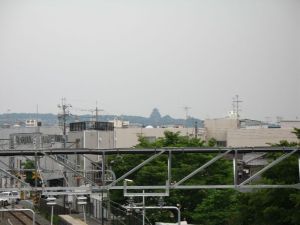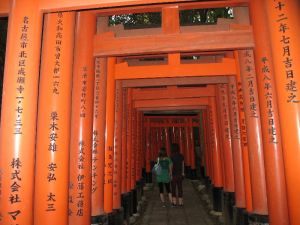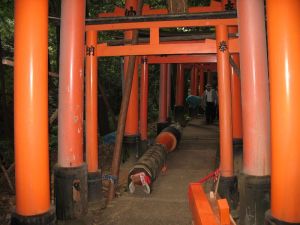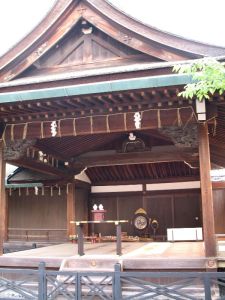I may be back in the States, but I still have Japan travels to talk about, so without further ado, here’s one of them. In May of 2008, I made a day trip to Fushimi.
Fushimi is now the southernmost ward in Kyoto city, but it used to be an entirely separate city and it has its own castle.
As seen from a train station. This is as close as I got.
Fushimi is the home of Gekkeikan, the world’s largest producer of sake. Gekkeikan makes a lot of cheap sake – a lot of cheap sake – but it has some higher quality products, too. It was the first brewery to sell sake in bottles instead of kegs and is still an innovator.
Gekkeikan was founded in 1637 and remains family owned. The old brewery is now a museum.
The buildings, which I believe date from around 1900, are so much more attractive than the concrete box warehouses that prevail today, don’t you think?
Of course, wooden buildings do make fires more of a danger. The adjacent canal may have helped mitigate that.
More importantly for daily business (a hundred or more years ago, that is), the canal provides access to a major river that was used to ferry sake and all manner of other goods to and from Kyoto and Osaka.
After seeing the museum, I had yakitori for lunch, at a restaurant run by another sake brewery, and then I took a short train ride to Fushimi’s most famous feature, Fushimi Inari Grand Shrine.
Established in the year 711, Fushimi Inari Grand Shrine is the main shrine of Inari, the kami of agriculture and industry. There are tens of thousands of minor shrines to Inari across Japan, often attached to temples or other shrines. Inari is said to use foxes as messengers, and you can always identify an Inari shrine by its fox statues.
At Fushimi Inari, businesses and individuals donate (ie, buy) torii gates to wish for success, and these torii make a loop up the mountain behind the main shrine that takes several hours traverse.
At the beginning of the path are two rows of small torii.
They practically form tunnels.
After a relatively short while, the small torii give way to large ones with more space between them.
Each torii has the name and address of its donor written on its uphill side. It was interesting to read them (those that I could read, anyway), and occasionally I saw some well known companies, such as Sapporo Beer.
It’s the one with the big writing.
I also saw new torii being erected.
The number of gates is just crazy, and the path takes hours to walk, as I said, but it’s not monotonous. At points, the torii stop for a while and there are other things along the trail.
I’m not entirely sure what these piles are, but my best guess is that they’re private offerings like the gates, but in the form of small shrines. In Japanese, they’re called tsuka (塚), which just means “mound.” The word tsuka also refers to burial mounds, but I don’t think these are graves.
Here’s a closer look at a mound.
Each torii along the path has 奉納, “dedication” or “offering,” written at the joins on its front side. These torii have that, too, but they also have a bunch of other writing. On the torii in front, there is the name of a kami on the cross piece – not Inari, but “Tamamitsu-ōkami,” who I don’t know anything about. The left post says “Erected on New Year’s Day, 2008” and the right post has an address and some names. “Jewel” (玉) is inscribed in the stone. Hmm . . . I wish I had a picture of a different mound to compare with this one. Oh well. In any case, as far as I know, these mounds are peculiar to Inari shrines.
Along the path, there is also a large pond and the occasional building.
And this cool dragon fountain.
And to abandon narrative entirely, in favor of the “Here’s a ___” blogging style, here’s a stage for ceremonial music and dance, back at the main shrine at the bottom of the trail.
That’s all for now.





























